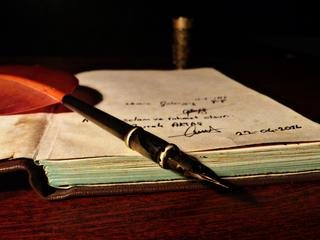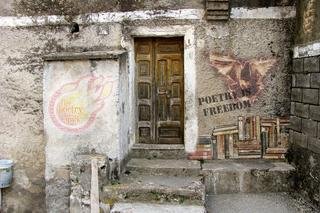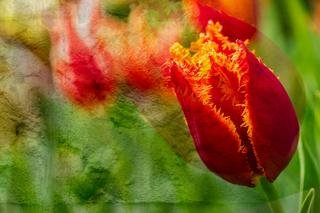The Writer: Writing Poetry

When I feel the need that something I want to say needs special attention, shape, and sound, I write poetry. Giving me the ability to decide where the lines end to control how the reader will hear and see the poem, and control the speed through the use of sound and rhythm to convey a meaning or message that I regard as a deep importance.
Learning to write poetry isn’t easy as most people think and great poetry is only written when there is deep involvement of heart and expression. Only at those high levels of expression does the author find deeper meanings. Poetry is fascinating and a unique form of writing to express feeling and deeper meanings. And below is a basic guide I have written. Enjoy
What is Poetry?
Poetry is a form of writing that uses style, rhythm, shape, and sound to give special intensity of expression.
Note to Reader
Poets are writers and it is necessary to learn to observe the world around you. Through observation and expression a poem can be sparked into life, and it can be about anything you feel that needs a certain shape and sound to express the meaning you want to convey, anything from heart ache to a wild flower growing in the fields. Writing poetry can be tricky, and takes creative poetic ideas to create a poem from scratch. If you are not a natural writer or creative you still have the ability to write poetry, it all about having inspiration, a little knowledge, emotion, and the right approach and you can write poems worthy for publication.

The Control Panel of a Poet
- Theme: The overall abstract idea or message
- Subject: Topic of a poem
- Structure: How the reader will see the poem
- Sound and Rhythm: The way reader will hear the poem
- Tone: Who is speaking in the poem
- Expression: Emotion in the poem
Note: The poets control panel is what gives the poet the ability to install an emotional output to make suggestions beyond what the poem actually is saying. An important aspect to remember, it is not what the poems says or describes, but what the reader imagines that causes the strongest emotional output.
1. Theme
The theme of a poem is the overall abstract idea the poet wants to express to the reader. In other words it is the deeper meaning hidden inside a poem that the reader must dissect to understand. Theme explores ideas through the subject and the reader must determine the overall theme by reading closely and dissecting the information given.
Common Themes
- Death
- Knowledge
- Love
- Danger
- Power
- Loneness
- Etc.
Once you have determined the theme of your poem figure out how the meaning will be impacted by the subject, and determine the motif and subject connections to the theme. When choosing a theme consider the ideas are you trying to express through the subject.
Poetic Devices for Theme
- Metaphor
- Simile
- Rhyme
- Symbolism
- Mood
- Irony
- Paradox
- Imagery
- Pun
- Etc.
Note: Theme helps the poet find the proper tone to fit the poem. Theme can be a lesson, message, moral idea, or expression of an idea. Through the use of theme the poet can control the overall abstract idea that lies hidden in the work. Understand that theme doesn’t have to be hidden; it can bluntly stated in the first line or the last. Remember, theme is the moral idea you are trying to convey through the use of poetic devices.
2. Subject
The subject is the topic of poem. It can be a person, place, thing, or an idea. Great poets use the subject to convey the deeper meanings they are trying to distribute to the reader. And not all poems have just one subject, there can multiple subjects throughout the poem, and not all subjects are clear to the reader. Sometimes the subject is simple, other times it can be difficult to determine.
Common Subjects in Poetry
- Love
- Hate
- Pain
- Nature
- Death
Poetic Devices for Subject
- Imagery
- Sensory Details
- Word Pictures
- Similes and Metaphor’s
- Allusion
- Situation
- Dramatic
- Exaggeration
- Etc.
Note: Poets can write on any topic they choose. You the poet have the power over subject to use it as a poetic device to express deeper meaning. Don’t over think the subject, just write and let the words be free. Just remember you have the power to expressive over clarity, it is your choice. Point of the subject is to lay the foundation for the overall structure of the poem, once the foundation is laid introduce other ideas and abstract meaning.
3. Structure
Structure is how a poem is organized and the way a reader will see the poem on a page. Consider how the poem will be divided up, and determine if the poem will be written in line, stanzas, etc.
Things to Consider
- Discussion or subject of the poem
- How is each section of poem the related
- Viewpoint
- Mood
- Emotional link between ideas
Poetic Devices for Structure
Stanzas: A grouping of lines. To determine a stanzas count the number of lines
Lines
- Couplet - 2 lines
- Tercet - 3 lines
- Quatrain - 4 lines
- Cinguain - 5 Lines
- Sestet or Sexain - 6 lines
- Septet - 7 lines
- Octave - 8 lines
Form: Form is basically style or format.
- Lyric Poetry: A poem with one speaker.
- Narrative Poem: A poem that tells a story.
- Descriptive Poem: A poem that describes imagery.
- Sonnet: A lyric poem consisting of 14 lines.
- Ballad: A narrative poem that has a musical theme.
- Epic: A long narrative poem where a hero is recounted.
- Free Verse: Poem that has no fixed pattern.
Note: Above are just a few examples of structure.
Note: Structure is important in writing poetry, for it tells the reader the poet’s attitude toward the chosen subject. The lack of structure will work against you and will not convey the desired message to the reader. Take great care on the overall structure, for it must represent what you are trying to say. Structure helps convey a deeper massage than what is being said.
4. Sound and Rhythm
Sound is the way reader will hear the poem. A poem must please the reader’s ear by carefully arranging words so certain sounds stand out. There are many ways this can be done, such as, repeating consonant sounds and vowels sounds, sensory details, similes, metaphors, etc.
Things to consider
- Accented and unaccented syllables
- Alternating unaccented and accented syllables
- Feet per line
- Type of meters
- Rhythm
- Stressed or repeated words
- Special affects
- Rhyme
- Voice
Note: The sound of your poem is important, like talking, a person can understand your mood and meaning through the sound of your voice. Do research and learn feet per line, meters, etc. Learn different forms and styles and learn to put your own voice to those forms. Create a rhythm. Rhythm is what gives poetry its sound, and do not underestimate, many factors of a poem relate to rhythm. A poem should flow easy out the mouth. When writing a poem read it out loud, can you feel sound of language? Can you feel the words on the tip of your tongue rolling in a rhythm?
Poetic Devices for Sound
- Assonance: The rhyming of vowels sounds
- Alliteration: The repetition of consonants
- Rhyme: Resonance when a word echoes the sound of another word – in:
- End rhyme
- Internal rhyme
- Perfect rhyme
- Slant or imperfect rhyme
- Feminine rhyme
- Masculine rhyme
4. Metrics: The notation system of rhythm. Common used Metrics:
- Iamb
- Trochee
- Anapest
- Dactyl
- Spondee
Poetic Devices for Rhythm
- Foot
- Meter
- Iambic Pentameter
- Anapestic trimester
- Trochaic hexameter
- Stressed and Unstressed Syllables
- Accent
- Etc.
Poetic devices for Voice:
- Denotation: Indicate. Indication. The dictionary meaning of a word.
- Diction: The combination of words. Word choice.
- Persona: A speaker pretending to be someone else or what they really are. Assumed voice. Mask.
- Connotation: Indirect meaning of a word or associative meaning of a word.
- Personification: Humanizing. To represent a person.
- Syntax: Arrangement of words in a peculiar way in the sentence structure.
- Rhetoric: Fancy words used in effective ways to give a general impression.
Note: There is a debate among poets that sound isn’t as important as meaning, but I think it is as equally important. Only through sound of voice can a meaning be conveyed. Voice in poetry is the same as writing fiction; it is the unique signature of the poet.
5. Tone
Tone is the attitude (mood) of a poem. It is the tone of voice used by the poet to convey meaning to the reader. Tone doesn’t have to be consistent through out the poem; it can change as the poem progresses. Tone can be sad, happy, humorous, etc. When a reader reads your poem they will interpret subject matter, reader, and meaning through tone of voice. Through the use of tone the poet can shift the poem to convey deeper meaning, and give the reader a more enjoyable experience. Tone is the style the poet chooses to expresses attitude and meaning by implementing poetic devices.
Poetic Devices for Tone
- Vocabulary
- Syntax
- Rhyme
- Rhythm
- Language
- Etc.
Note: The attitude (mood) the poet expresses on subject and audience is through tone.
Two Attitudes of Tone
- Audience
- Subject
When writing your poem keep in mind that you have an audience and a subject, and it is critical to analyze and interpret the attitude, analyze as if someone is speaking to you. Always keep in mind what the tone suggest toward the subject and the general emotional you want the reader (audience) to interpret, and the general attitude toward the reader (audience) and the subject.
Tone Moods (Emotions) to consider
- Serious
- Humorous
- Angry
- Formal
- Playful
- Happy
- Sad
- Love
- Etc
Note: When writing a poem be sure the subject has emotional connection, so, the reader can discover the attitude you have toward the subject and audience. By having an emotional connection it gives voice of authenticity in the poem. The poem must feel real, the reader must know you have experienced what you are writing about. It makes the poem feel real to the reader if they believe that you and the reader share similar experiences. Through tone you can accurately convey your attitude and emotions to the reader.
Also take note that mood creates the atmosphere of the poem. Tone evokes emotions in the reader to help convey the deeper meaning hidden in the poem. It is your job to express tone of voice to create the attitude and atmosphere to give the reader poetic insight.
As a poet, always consider tone and as a writer in general always sharpen your skill, having a strong and unique tone of voice is critical in any form of writing.
Note: Tone is sound, and you may wonder why I didn’t put tone under the subject of sound. The reason is, tone is super important in poetry and writing in general, and I wanted to express to the reader its importance, so, I gave its own section to let the reader know to never underestimate tone.
6. Expression
The most important part of any poem is expression. Without expression there is no poetry. You must be able to make the reader feel the emotion you are trying to convey. Must be able to make the reader like what the poem says. It is this reason alone why it is important to have great emotion when writing poetry.
The Two Components of Expression
- Mind: A reader likes a poem for what it says
- Heart: A reader likes a poem for how it makes them feel.
Note: Never underestimate the power of expression of emotion. You as the poet must be able to please the mind and heart of the reader, and the only way that can be done is through expression of emotion. If not, don’t waist my time or anyone else’s. When I read a poem I want to feel the poem, I want the poem to linger in my mind.
Poetic Devices for Expression
- Idiom
- Sensory Details
- Word Pictures
- Imagery
- Allusion
- Anagram
- Analogy
- Anastrophe
- Etc.
Note: Expression is a key element in poetry. The poet must be able to convey emotion to the reader, if not all is lost. There is no standard way to use expression; it is something you must feel when you write. And if the expression is present then emotion will come and beautiful and meaningful poetry will be created. It is expression that gives poetry its great power in literature.

Summary
Above is a basic guide to use when writing poetry. There is no correct or wrong way to write poetry. The only requirement is to write with great emotion to express the overall meaning you wish to convey.
There is a poet in all of us, and each of us possess at least one great poem, and learning how to write poems will allow you to express your feeling and ideas through the use of beautiful sounds of language. Study and read, most of all write. Only through writing can you learn to express yourself through poetry. You are a human being, and humans are emotional creatures who love, cry, get angry, and smile, and because of emotions we created the greatest invention of all, language, and through language we have the ability to express and share ideas through the magic of poetry.

“Poetry is when an emotion has found its thought and the thought has found words.” ~ Robert Frost
Follow. Up-Vote. Resteem.
@smackit

Image Source:
https://cdn.pixabay.com/photo/2017/10/08/21/03/rose-2831613_960_720.jpg
Image Source:
https://cdn.pixabay.com/photo/2016/05/07/19/01/feather-pen-1378026_960_720.jpg
Image Source:
https://cdn.pixabay.com/photo/2017/10/29/01/17/graffiti-2898656_960_720.jpg
Image Source:
https://cdn.pixabay.com/photo/2017/02/18/13/13/bed-2077183_960_720.jpg
Image Source:
Wow!!! This one of the best post I've come across. So much crap on the platform its hard to find good content. thank for uploading. dedicated follower. Great post!
@galatichunter
Thanks for the awesome comment. I'm glad you you liked it. I put a lot of work in this post. Thanks
Thank You
This post has received a 0.81 % upvote from @speedvoter thanks to: @smackit.
A digital electric smoker uses electricity to generate heat and smoke, which cooks the meat. The temperature and smoke are controlled electronically, making it easier to maintain a consistent temperature throughout the cooking process. https://perfectelectricsmokers.com/best-electric-smoker-for-cold-weather/